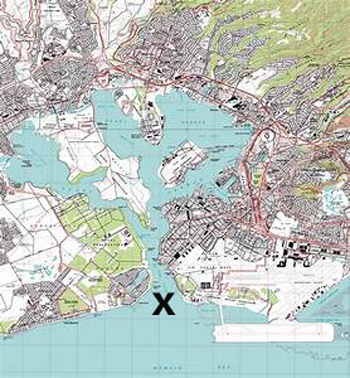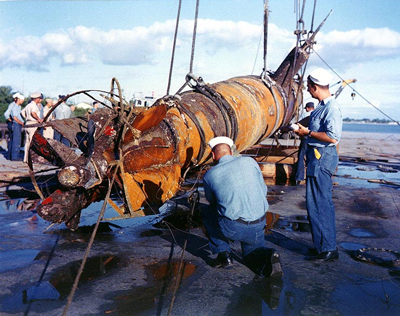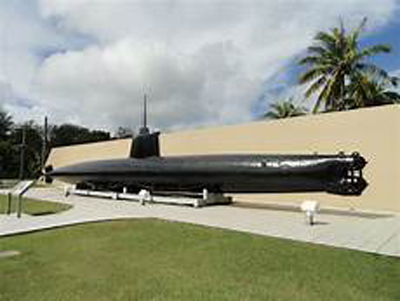Pearl Harbor Discovery Has Ironic Twist

The two man Japanese submarine was sunk near the entrance to Pearl Harbor. Credit: Ellsworth Boyd Shipwreck Archives
Diving in cramped quarters aboard the University of Hawaii Undersea Research Lab’s submersible, Pisces V, the trio was about to call it quits after six hours on the bottom searching for WWII aircraft. “That’s when,” as Carter described it, “a big dark shadow appeared from out of nowhere.” A closer look revealed the stern section of a two-man Japanese midget submarine sunk shortly before the attack on Pearl Harbor.
A history buff, accredited by the Institute of Aeronautical Archaeological Research, Auburn, California, Carter recognized the sub’s remains right off the bat. He knew the U.S. Navy had been searching in this area for a long time, a one to five mile radius earmarked as the “entrance to Pearl Harbor.” Reluctant to claim a find that wasn’t intact, the dive team took their video of what they found to the curator at the Battleship Arizona Memorial who confirmed it was indeed the highly sought midget submarine.

Japanese midget submarine found in Pearl Harbor, 1965. Credit: National Archives
Through research, Carter found five midget class subs were launched offshore from Japanese mother ships at about midnight, December 7, 1941, with orders to sneak in as close to the harbor as possible and wait for the attack. Fortunately, none of them were successful in firing their torpedoes. One of them washed ashore at Bellows Field on the northeast corner of Oahu, while another was rammed and sunk by the patrol destroyer USS Monaghan. Still another one was found by Navy divers inside the harbor in 1965. The one Carter & his team discovered was sunk by the patrol destroyer USS Ward and the fifth one disappeared without a trace.
Ironically, the first shot of the battle at Pearl Harbor came from an American destroyer, not an airplane and the first blood shed was Japanese when the midget sub went down. At 6 am, December 7, Commander Lawrence Grannis, skipper of the Antares, a supply ship heading for Pearl Harbor, spotted a “strange, suspicious looking object” that resembled a submarine. He immediately notified the USS Ward cruising in these same waters.
When the lookouts aboard the destroyer spotted the sub, they were dumbstruck having “never seen anything like this in the U.S. Navy.” General quarters were sounded and the destroyer pulled to within 50 yards of the target and commenced firing. The first shot missed, but the second one hit the sub at its water line. As the invader heeled to its starboard side, the attacker finished it off with depth charges. Captain William Outerbridge immediately reported to the 14th Naval District: “Attacked, fired upon and depth charged a submarine operating in a defensive area.” Records later showed the Bishop Point radio station had logged this in exactly one hour before the air strike on Pearl Harbor.

Midget submarine on display at Japanese Naval Academy, Etajima, Japan. Credit: Sadamu Takahashi
But by the time word of the attack worked its way through the Navy’s chain of command, up to Fleet Commander Admiral Husband E. Kimmel, it was 7 am, 30 minutes before the sneak attack. Unfortunately, Kimmel, having received many false reports of submarines in the outlying area, asked for confirmation of the report and ordered another destroyer to leave port and check it out. But again, by the time one guy talked to another guy—some discussions lasting as long as 10 minutes—precious time slipped by and the Japanese attack ensued.
Another twist of fate evolved from post Pearl Harbor investigations. On one hand, the Japanese Fleet Commander Chuichi Nagumo had been uneasy about the strategy of launching the two-man subs for fear one might be spotted and tip off the attack. Kimmel, on the other hand, had always been apprehensive about Japanese submarines, fearing they might someday attack his ships. Both commanders were correct, only Nagumo was a lot luckier than Kimmel. The time delay was in his favor.
To the readers of this article: I want your opinion. The report of the sinking of the sub was one hour before the attack. The Navy’s red tape and time delay resulted in no preventive action. Now, suppose the report went right through and action was taken. That would have been one hour before the attack. Would it have mattered? Remember, it was a Sunday and the ships had skeleton crews aboard them. How long would it take to fire up the big vessels and get them out of the harbor? Speculate a bit and offer a comment. Give your opinion as to whether that one hour would have made any difference, Thank you. Ellsworth Boyd
Author: Ellsworth Boyd
Ellsworth Boyd, Professor Emeritus, College of Education, Towson University, Towson, Maryland, pursues an avocation of diving and writing. He has published articles and photo’s in every major dive magazine in the US., Canada, and half a dozen foreign countries. An authority on shipwrecks, Ellsworth has received thousands of letters and e-mails from divers throughout the world who responded to his Wreck Facts column in Sport Diver Magazine. When he’s not writing, or diving, Ellsworth appears as a featured speaker at maritime symposiums in Los Angeles, Houston, Chicago, Ft. Lauderdale, New York and Philadelphia. “Romance & Mystery: Sunken Treasures of the Lost Galleons,” is one of his most popular talks. A pioneer in the sport, Ellsworth was inducted into the International Legends of Diving in 2013.
16 Comments
Submit a Comment
All Rights Reserved © | National Underwater and Marine Agency
All Rights Reserved © | National Underwater and Marine Agency
Web Design by Floyd Dog Design
Web Design by Floyd Dog Design

I heard about these subs…. but I don’t think an hour would have made much difference…
good article
Thank you, I’m glad you liked my article. It was interesting to write about this midget sub discovery and to research the others. I will be interested to see what other viewers have to say. Best regards, E.
An hour would have made no difference and I feel that the time it would have taken to get the engines ready and crews assembled would have far surpassed that hour
That is a very good point. Thanks for your response. I will be eager to see what other viewers have to say.
An hour would have made a lot of difference. It would have given the armed forces over there time to organize their troops.
What if we were able to man all of the anti-aircraft guns and put all of our fighters in the air before the attack.John M. Welcher
sure there would have been a lot of damage but just think of all of the damage we would have caused to the Japanese and the American lives that would have been saved by being forewarned so we could defend ourselves.
Excellent comments. I think you have made some good points. Thanks for your interest.
Simply giving the Navy time to put anti-torpedo nets in the water, and getting anti aircraft batteries manned could have made a big difference. Plus men at battlestations, maybe fewer lives lost. Even a handful of fighters in the air could disrupt attack formations. A lot of “what if” scenarios.
Yes, many “what if” scenarios. I agree. If we could have gotten our planes in the air (many were caught on the ground and bombed) I think that could have helped our cause a lot. Thanks for your reply.
Always thought that a ‘what if’ kind of Clive Cussler novel about the attack on Pearl Harbor being allowed to happen would be cool.
RIP Clive.
This is an excellent idea. Perhaps Clive’s Son, Dirk, could write this. I’m very sorry to inform you that Clive passed over the bar last Monday. May God bless and keep him. Sincerely, Ellsworth
I would have thought that the defense of the Pacific Fleet and Pearl Harbor, defense of the Harbor should have been in place as a matter of course long before December 1941.
Clive and Dirk Pitt has brought a lot a pleasure over the years. RIP Clive
Yes, and we all miss him. Perhaps Clive’s son, Dirk, will continue in his Dad’s footsteps.
To Paul: Actually, I believe the defense was there, but it was a Sunday and only skeleton crews were at the stations. And even some them were unmanned. The “sneak attack” is what did us in on the defense. Patrol boats, operating ’round the clock might have given an early warning. But there were none. The discrepances continue.
Well, for openers, both the Army and the Navy in Hawaii received “War Warnings” from D.C. that failed to materialize in November. False Alarms. Secondly, there was no interoperability from those Branches of Service ( They didn’t talk to each other – “no coordination”. The Army Ar Corps didn’t have aircraft to fly long distance “early warning” patrols. No SOP for local Combat Air Patrols” by shorter range pursuit planes. And remember- Two Radar Operators picked up a large flight in the North and passed it on to the Duty Officer who failed to act on it. Made an assumption that it was the B-17’s coming from the West Coast (by way of the North ????) . So the Army was not prepared. As for the Navy, large ships cannot “sortie” with skeleton crews. Heading for open sea in anticipation of an aerial attack requires gun crews, ammo handlers, an adequate number of crew in engineering and the boiler rooms, and probably most of all, fully manned damage control parties. One would have to determine how long it takes to work up steam, cast your lines and take a 30,000 plus ton ship down the channel to open sea. And with (what was it ?) 90 plus ships at Pearl, how many others would be in that Rumba line to exit the harbor, apart from the Battleships? Don’t quote me, but I believe it was Nimitz who stated that having those ships sunk in harbor at anchor was far better than having them lost at sea. After all, all but three were salvaged , repaired, modernized, equipped with far better AAA, and back in service during WWII. And how many more men do you lose when a ship is sunk in open waters ? And you lose the ship forever to Davy Jones. The only bonus that day was the failure by Nagumo to launch a third air strike. If he had hit the oil farms and submarine base we would have been up “you know what’s” creek
Thanks for your comments Vernon. I too believe that we knew something was going to happen in the vicinity of Pearl Harbor. Good point about Nagumo. We had a lot of things going against us that infamous day, but we did get a bonus or two along the way.